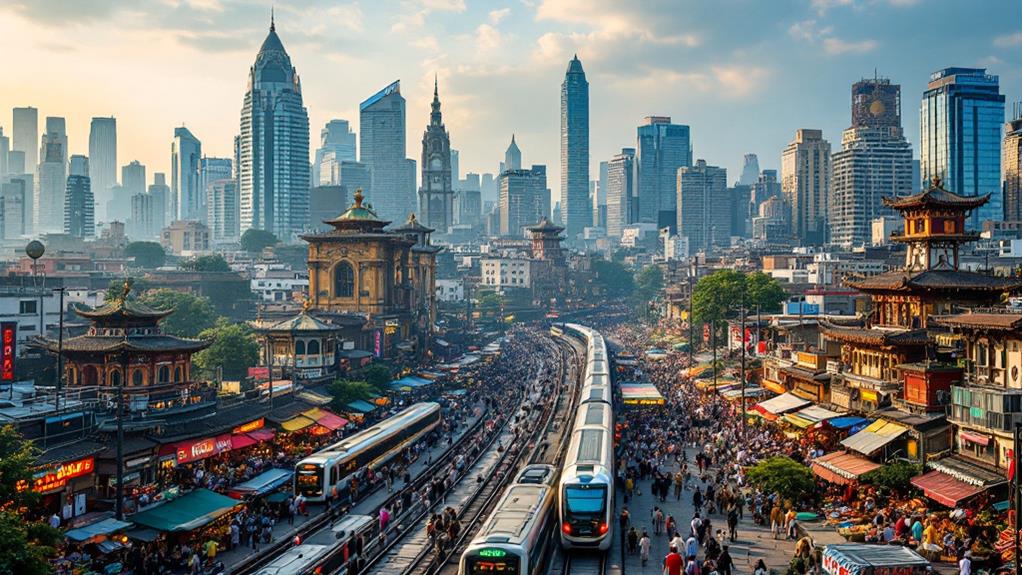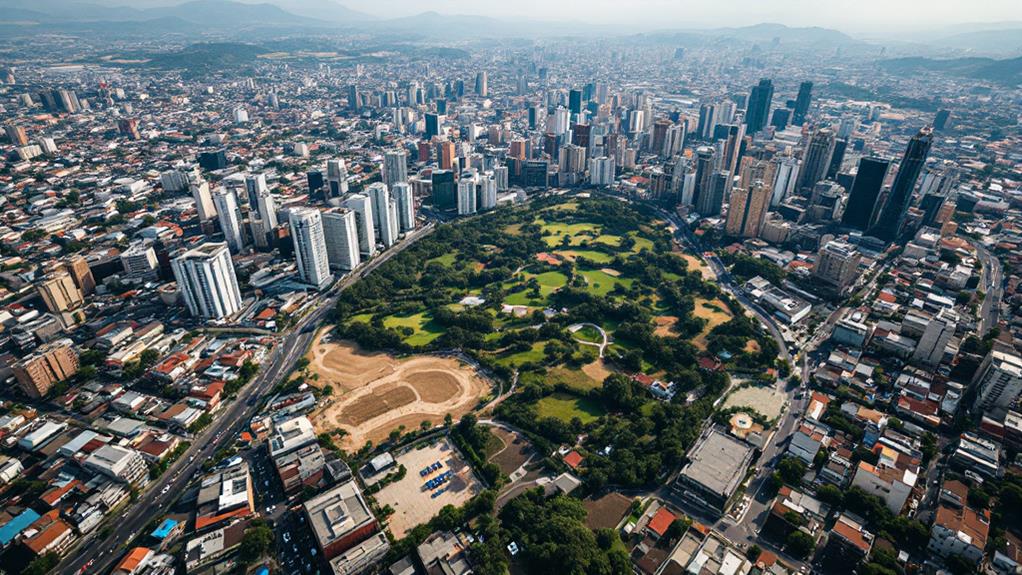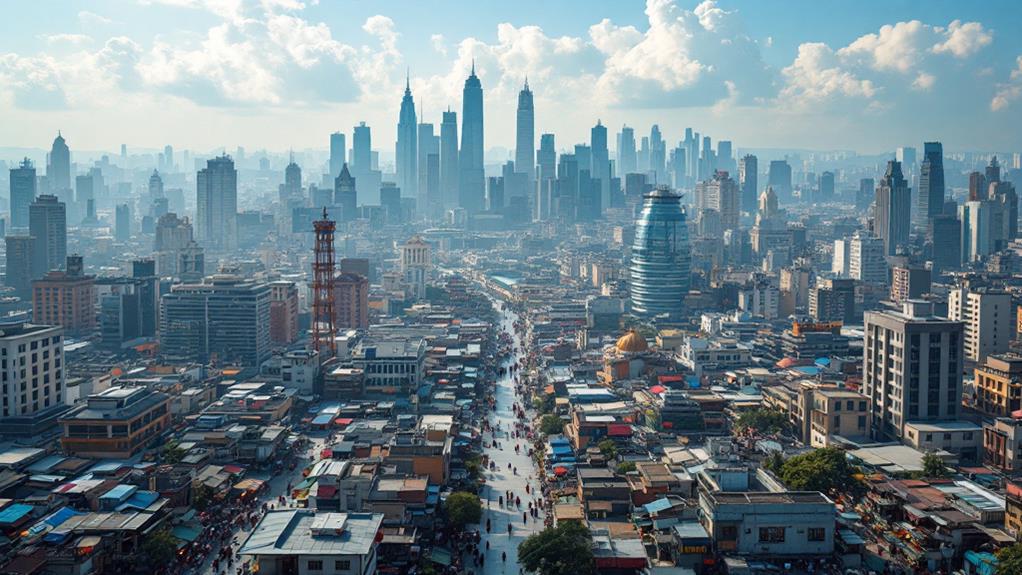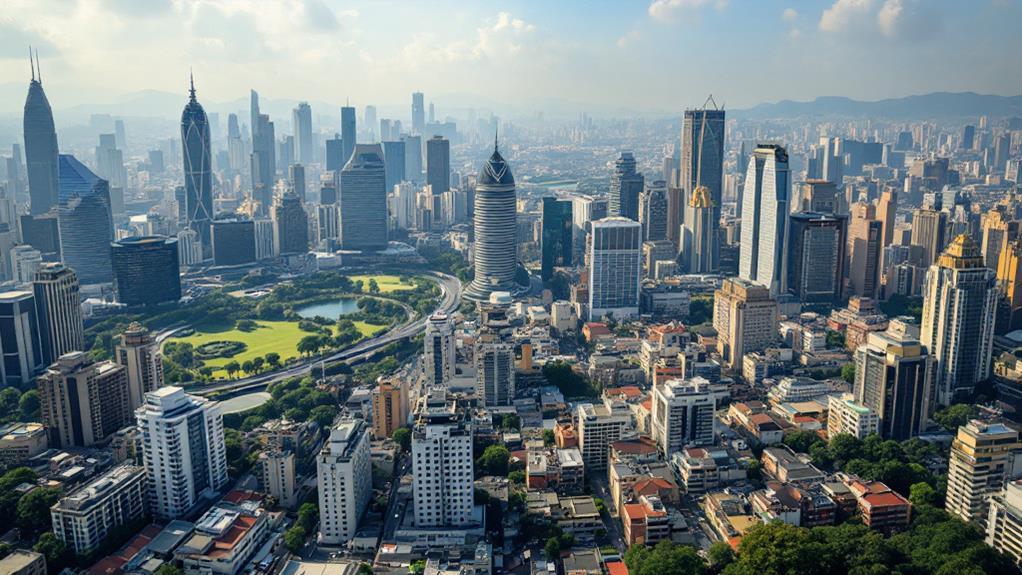Biggest Differences Between the Largest Urban Areas in Developed and Developing Countries

When you look at the largest urban areas, you'll notice distinct differences between those in developed and developing countries. Urban areas in developing regions tend to have skyrocketing population densities, often without the economic growth to match. In contrast, developed cities enjoy advanced infrastructure and sophisticated land use, utilizing vertical growth. Environmental challenges are more pronounced in developing nations due to rapid, unplanned expansion, while developed areas feature more sustainable practices. These variations impact everything from economic contributions to public health and environmental sustainability. There's much more to investigate about these fascinating dynamics and their global implications.
Urban Growth Dynamics
Urban growth dynamics have dramatically shifted, especially in developing countries where urban populations have surged despite limited land. You can see this in the fact that 74% of the population in a sample of 1,000 cities are located in poorer nations, which account for only 50% of the land area. This rapid urbanization is driven by rural-urban migration, creating a spike in population density. As cities in these regions grow denser, the economic development doesn't always keep pace, leading to unique challenges and opportunities.
In contrast, wealthier nations expand city size by utilizing more land and constructing taller buildings. The Standard Urban Model suggests that population density inversely relates to transportation costs and income levels, which means as these factors change, so does the urban landscape. Notably, the elasticity of city size concerning income has shifted to zero, indicating that city expansion no longer directly correlates with economic growth.
Moreover, denser urban areas in developing countries can positively impact environmental outcomes. A 1% increase in city density correlates with a 0.58% reduction in CO2 emissions, highlighting how urban growth dynamics can influence both economic and environmental aspects of urban life.
Population and Density
Shifting focus from urban growth dynamics to population and density, it's evident that cities in developing countries face unique challenges due to their exceptionally high population densities. In these regions, urban areas represent 74% of the population across a sample of 1,000 cities, but they occupy only 50% of the land area. This stark contrast underscores the extreme density that characterizes megacities in developing countries. You may find that the average population density in these megacities can soar to 47,000 people per square kilometer, a figure much higher than in developed countries, where densities often stay below 20,000 people per square kilometer.
In developed countries, cities usually have more land area and taller buildings, contributing to lower densities. Despite the larger urban footprint, population growth has been more moderate, allowing for urban expansion. Meanwhile, the rapid population growth in poorer cities since 1960 has intensified their density issues. You might notice a disconnect between urban population size and economic growth in developing nations. Even with large populations, many densely populated cities exhibit low GDP per capita. This presents a challenge for economic growth, as high density doesn't necessarily translate into increased prosperity.
Land Use Efficiency

Efficiency is a crucial factor in determining the effectiveness of land use within urban areas. In developed countries, land use efficiency often shines through the strategic use of taller buildings and expansive land areas, allowing for both horizontal and vertical urban expansion. This approach accommodates a growing urban population while managing construction costs and enhancing welfare gains. On the other hand, developing countries frequently struggle with high population densities due to limited land area and space constraints. As a result, crowded living conditions become the norm, reflecting a less efficient use of available land.
In a sample of 1,000 cities, developing cities account for 74% of the urban population but only 50% of the land area, underscoring the stark differences in land use efficiency compared to their developed counterparts. The Standard Urban Model suggests that higher density in such cities correlates with increased land values and construction costs, further impacting efficiency. However, there's potential for significant welfare gains in developing countries by relaxing building height restrictions. Current practices may not be maximizing efficiency, but with strategic changes, these cities could better accommodate their growing populations and improve overall urban living.
Building Height Variations
How do building height variations shape the urban landscapes we see today? In developed countries, building height greatly impacts city skylines, with skyscrapers symbolizing extensive vertical expansion. These towering structures arise from sophisticated land use planning and zoning laws that encourage upward growth, accommodating population growth efficiently. Urban areas in cities like New York showcase this trend, where skyscrapers dominate, efficiently using available space to address density issues.
In contrast, developing countries often face challenges that restrict vertical growth. The regulatory frameworks in these regions prioritize rapid urbanization, yet they frequently impose height restrictions due to economic constraints and limited land availability. As a result, cities like Dhaka experience overcrowding with low-rise buildings, lacking the skyscrapers seen in developed nations. This approach often intensifies population growth through horizontal expansion rather than maximizing vertical space.
Ultimately, building height variations highlight a clear divide between urban areas in developed and developing countries. While rich countries utilize vertical expansion to address urban density, poorer nations struggle with land use constraints and regulatory challenges that hinder the construction of taller buildings. This disparity shapes the unique urban landscapes you observe across different regions worldwide.
Economic Impact of Urban Areas

Economic dynamics in urban areas play a significant role in shaping their growth and prosperity. In developing countries, these urban areas are important economic drivers. For instance, Karachi alone generates about 20% of Pakistan's GDP, underscoring the economic impact of megacities. However, rapid urbanization often results in economic disparities. High unemployment rates and a burgeoning informal sector frequently accompany formal employment structures, complicating the economic landscape.
In developed countries, urban areas contribute approximately 80% of global GDP. These areas benefit from agglomeration economies, which enhance productivity and innovation through concentrated business activities. This results in higher wages and better job opportunities compared to their developing counterparts. Employment rates in these regions often dictate the demand for housing, with land use policies playing a critical role in balancing supply and prices.
Whether in developed or developing countries, urban areas are at the heart of economic transformation. They not only drive national GDP but also influence global trade and investment patterns. Understanding these dynamics helps you appreciate the complex economic threads that define urban spaces worldwide. The challenges and opportunities presented by these urban areas require thoughtful policies to harness their full potential.
Environmental Considerations
While urban areas drive economic growth, they're also at the forefront of environmental challenges. In developing countries, urban sprawl often results in biodiversity loss due to habitat destruction. The rapid urbanization in these areas leads to infrastructure challenges that exacerbate air pollution and increase health risks. You'll find that the urban heat island effect is particularly severe, with unplanned development causing soaring temperatures and amplifying climate change impacts.
In contrast, developed countries typically have stringent environmental regulations aimed at reducing CO2 emissions. These regulations help mitigate the environmental toll of dense urban environments. Here, water resource management is usually more sustainable, with established frameworks ensuring that water sources aren't overdrawn, unlike the severe shortages seen in many developing megacities.
Furthermore, developed countries often integrate green spaces into urban planning, which not only helps conserve biodiversity but also reduces the urban heat island effect. On the other hand, developing regions struggle with balancing growth and conservation. As you navigate these urban landscapes, the stark differences in environmental considerations between developed and developing countries become evident, highlighting the need for strategic planning and sustainable practices globally.
Infrastructure and Planning

Skyscrapers and subways illustrate the stark contrasts in infrastructure and planning between developed and developing urban areas. In developed countries, you'll find extensive transportation networks, including subways and buses, that make commuting convenient. These systems are often a result of careful urban planning, emphasizing sustainability and smart growth strategies. In contrast, many developing countries struggle with inadequate transportation networks, relying heavily on informal transit options. This lack of planning often leads to unplanned urbanization, resulting in overcrowding and informal settlements.
Building height regulations in developed urban areas encourage vertical growth, offering efficient use of space and minimizing sprawl. Conversely, developing cities face challenges in enforcing such regulations, leading to horizontal sprawl and high-density crowding. Fundamental services such as clean water, sewage, and waste management are more accessible in developed areas, reducing public health risks. However, inadequate infrastructure in developing nations can cause significant health crises.
Technological infrastructure, including high-speed internet and smart city initiatives, is more prevalent in developed countries. They invest heavily in these advancements, enhancing urban living. Developing nations often lack resources for such implementations, widening the gap in infrastructure and planning quality.
Historical Influences on Urbanization
Urbanization's historical influences are essential in understanding the diverse landscape of today's cities. Since 1960, urban growth in developing countries has surged, marking a significant demographic shift. Historically, larger cities were in wealthier nations, but now, 74% of urban populations in a sample of 1,000 cities are in developing countries. This shift is partly due to colonial legacies that have shaped urban forms, especially in Africa. These legacies contribute to contemporary urban challenges by influencing economic and social structures inherited from colonial times.
The rise of megacities further illustrates rapid urbanization trends. From just five megacities in 1975, the number skyrocketed to 26 by 2015, with most located in developing regions. This growth often occurs through increased density and crowding, contrasting with the historical expansion in developed nations, which relied more on extensive land use and taller buildings. Notably, there's a disconnect between urbanization and economic performance, as evidenced by no clear correlation between urban population size and GDP per capita. This challenges the traditional notion that urban growth is tightly linked to economic prosperity, highlighting unique urbanization paths influenced by historical factors.



